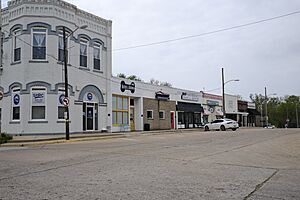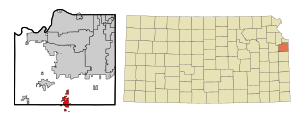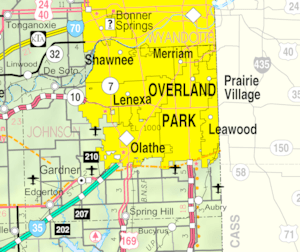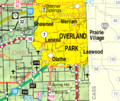Spring Hill, Kansas facts for kids
Quick facts for kids
Spring Hill, Kansas
|
|
|---|---|

Downtown (2022)
|
|

Location within Johnson County and Kansas
|
|

|
|
| Country | United States |
| State | Kansas |
| Counties | Johnson, Miami |
| Founded | 1856 |
| Incorporated | 1857 |
| Named for | Spring Hill, Alabama |
| Area | |
| • Total | 9.46 sq mi (24.50 km2) |
| • Land | 9.35 sq mi (24.22 km2) |
| • Water | 0.11 sq mi (0.29 km2) |
| Elevation | 1,063 ft (324 m) |
| Population
(2020)
|
|
| • Total | 7,952 |
| • Estimate
(2022)
|
9,242 |
| • Density | 988/sq mi (381.6/km2) |
| Time zone | UTC-6 (CST) |
| • Summer (DST) | UTC-5 (CDT) |
| ZIP Code |
66083
|
| Area code | 913 |
| FIPS code | 20-67625 |
| GNIS ID | 479558 |
Spring Hill is a city located in Johnson and Miami counties in the U.S. state of Kansas. It is also part of the larger Kansas City Metropolitan Area. In 2020, the city had a population of 7,952 people. By 2022, this number was estimated to have grown to 9,242.
Contents
History of Spring Hill
Spring Hill was founded in 1856 by James B. Hovey. He named the community after a town in Alabama. Hovey believed it was a great spot for a town because it had good timber, water, and was on a main travel route. He also became the first postmaster for the community. In 1856, Hovey built the first building, which was the Spring Hill Hotel. It was a two-story building also known as the "Old Traveler's Rest."
Early Settlers and Challenges
In January 1859, Celia Ann Dayton moved to Spring Hill. She was a doctor from Vermont and became the first woman doctor in Kansas. She arrived with her adopted son, Hiram Eugene, who was also a doctor. Celia was known for helping black refugees and was reportedly part of the Underground Railroad.
In 1862, during the American Civil War, Hiram was killed while working as a spy for the Union. That same year, Celia divorced her husband, which was very unusual for that time.
Surviving the Quantrill Raiders
Spring Hill faced danger during the Civil War. In the fall of 1862, a group called Quantrill's Raiders was heading towards the town. A clever farmer talked to them and convinced them that soldiers were in Spring Hill, even though there weren't any. This made the Raiders turn away.
However, a year later in 1863, the Quantrill Raiders did attack Spring Hill. They stole from businesses and local farmers. Sadly, at least one person from the town was killed.
Growth and Economic Struggles
By the 1870s, Spring Hill was growing with more people and businesses. A railroad company wanted to build tracks through the town. But they asked the residents to pay $15,000 to prepare the land. The residents didn't want to pay, so the railroad tracks were built about half a mile east of the original town center. Many businesses then quickly moved closer to the new train depot and tracks.
In 1874, the country faced an economic depression, which also affected Spring Hill. That same year, huge swarms of grasshoppers caused a lot of damage. They ate plants, clothes, blankets, and even leather items. This led to polluted water and ruined crops, making life very difficult.
Modern Development and Education
In the 1920s, the Spring Hill Rural High School District was created. The city's first jail was built in 1926. By the 1950s, most of the areas around Spring Hill had electricity.
In the 1960s, Spring Hill's elementary and high schools combined. This happened because of a state law that required public schooling for all grades, from kindergarten to 12th grade. Spring Hill's growth slowed down in the 1980s. To fix this, community leaders decided to attract new industries. This plan worked, bringing in new residents and more businesses.
The Ruskin Heights Tornado
On May 20, 1957, a very powerful tornado, known as the Ruskin Heights tornado, hit Spring Hill. It destroyed a steel factory, 21 homes, and 18 barns. The cemetery also suffered a lot of damage to its trees and gravestones.
The only people who died in Spring Hill were the Davis Family: Isam, his wife Barbara, and their young daughters Tamara and Pamela. They were killed while trying to escape the storm in their car. Their home was completely destroyed. Davis Street in Spring Hill is named after this family.
Celebrating Spring Hill's Past
Spring Hill was officially incorporated as a city in 1857. In 2007, the city celebrated its 150th anniversary. Today, Spring Hill hosts several fun community events each year. These include The King of the Hill Barbeque, the Spring Hill Fall Festival, and Hometown Holidays.
Geography of Spring Hill
Spring Hill covers a total area of about 9.46 square miles (24.50 square kilometers). Most of this area, 9.35 square miles (24.22 square kilometers), is land. A smaller part, 0.11 square miles (0.29 square kilometers), is water.
Population and People
| Historical population | |||
|---|---|---|---|
| Census | Pop. | %± | |
| 1880 | 502 | — | |
| 1890 | 573 | 14.1% | |
| 1900 | 580 | 1.2% | |
| 1910 | 605 | 4.3% | |
| 1920 | 555 | −8.3% | |
| 1930 | 566 | 2.0% | |
| 1940 | 489 | −13.6% | |
| 1950 | 619 | 26.6% | |
| 1960 | 909 | 46.8% | |
| 1970 | 1,186 | 30.5% | |
| 1980 | 2,005 | 69.1% | |
| 1990 | 2,191 | 9.3% | |
| 2000 | 2,727 | 24.5% | |
| 2010 | 5,437 | 99.4% | |
| 2020 | 7,952 | 46.3% | |
| 2022 (est.) | 9,242 | 70.0% | |
| U.S. Decennial Census 2010-2020 |
|||
What the 2020 Census Shows
According to the 2020 census, Spring Hill had 7,952 people living in 2,763 households. About 2,133 of these were families. The city had about 906.7 people per square mile.
Most of the people in Spring Hill were white (88.03%). Other groups included black or African-American (1.96%), Native American (0.41%), and Asian (0.69%). About 5.8% of the population was Hispanic or Latino.
In terms of households, 44.7% had children under 18. About 61.2% were married couples living together. The average household had 3.1 people.
The median age in Spring Hill was 30.8 years. About 27.2% of the population was under 18, and 7.3% were 65 or older.
What the 2010 Census Showed
In the 2010 census, Spring Hill had 5,437 people living in 1,919 households. The population density was about 638.1 people per square mile.
The racial makeup was mostly White (93.7%). About 4.0% of the population was Hispanic or Latino.
About 46.3% of households had children under 18. The average household size was 2.81 people. The median age in the city was 32.3 years.
Arts and Community Life
Spring Hill is a lively community with many annual events. These include The King of the Hill Barbeque, the Spring Hill Fall Festival, and Hometown Holidays. The city also has a golf course called Sycamore Ridge. Many local groups and businesses hold golf tournaments there.
The Johnson County Library has 13 locations, and one of them is the Spring Hill Library.
Education in Spring Hill
The public schools in Spring Hill are part of the Spring Hill USD 230 school district. This district includes 5 elementary schools, 3 middle schools, and 1 high school.
- Prairie Creek Elementary School (grades K–5)
- Spring Hill Elementary School (grades K–5)
- Wolf Creek Elementary School (grades K–5)
- Timber Sage Elementary School (grades K–5)
- Dayton Creek Elementary School (grades K–5)
- Spring Hill Middle School (grades 6–8)
- Woodland Spring Middle School (grades 6–8)
- Forest Spring Middle School (grades 6–8)
- Spring Hill High School (grades 9–12)
Notable People from Spring Hill
Spring Hill has been home to several interesting people:
- Curly Brown (1888–1968), a baseball pitcher.
- Ula Sharon (1905-1993), an American dancer.
- Gary Burrell (1937–2019), who helped start the company Garmin.
- Stephen Chamberlin (1889–1971), a U.S. Army Lieutenant General who received the Navy Cross.
Images for kids
See also
 In Spanish: Spring Hill (Kansas) para niños
In Spanish: Spring Hill (Kansas) para niños



